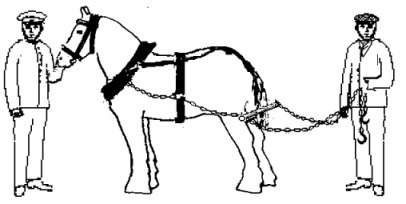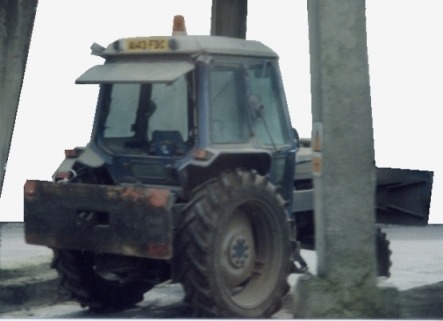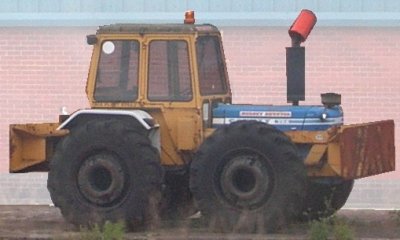Larger industries were usually rail connected prior to the 1960's but they are technically 'outside the railway fence' and are dealt with separately under Lineside Industries.
Some industriues, usually in rural areas, were required to provide a 'public wharf' with its own siding when having a private siding laid into their works. These appear to have had no facilities other than a raised loading bank and were presumably intended for agricultural traffic. Since the 1970's there have been some privately owned goods yards but I believe it is only since the 1980's that these yards have acted as (semi) public yards handling goods for people other than the owners of the yard. My own interests peter out toward the end of the green diesel period (mid 1960's) so I am not fully conversant with the operations of companies such as Isis Link and I am unsure as to how the private terminals are operated.
Shunting
In all these yards it was usually necessary to move wagons from place to place, this is called shunting. Marshalling yards usually had a dedicated shunting locomotive (called a 'pilot') or two to handle shunting duties. Large goods yards sometimes had a shunting locomotive but at smaller yards the loco working the goods train would usually handle any shunting that was required. Within the yard horses were often used for moving wagon about and there might be 'capstans', powered or unpowered vertical drums, set into the yard to assist. A wagon or short rake of wagons could have a rope attached, this could be lead to a horse or to a powered capstan where it was thrown over the capstan in a series of turns to drag the wagons to the required area. Horse shunting is discyssed below, capstans are more fully discussed in the section on Track & Gauge - Turntables, points and slips.
The non-automatic three link type couplings used on British stock required a man to attach the coupling and several companies built small four wheel trucks which could be attached to a shunting engine to carry the shunter and his pole. These usually had a tool box although I am not sure what that contained. The LMS shunters truck was a standard nine foot wheelbase chassis with a plain deck carrying a toolbox, foot boards and grab rails along the sides. A the GWR used a purpose built seven foot wheelbase chassis, again with foot boards and grab rails. I built one of the latter to run with a small 1366 class dock pannier tank, a kit running on a Minitrix chassis. The model was made by fitting a cut down Peco single bolster wagon body onto a cut down Peco 10' wheelbase brake van chassis, the tool box is a block of Milliput with detail added from Microstrip and the hand rails are florists steel rose wire. A P D Marsh one plank body kit would be a better starting point as the additional weight would be useful.
Fig___ GWR Shunters Truck

I fitted Farish metal wheels and added wire wipers to the underside. The engine was fitted with a pair of brass tubes araldited to a plasticard plate and flexible wires from the pickups were soldered to brass rods bent into an inverted U shape that were a snug fit in the tubes, from which wires ran to the motor. The additional pick-up from the truck improved the performance of the little engine on insulfrog settrack curves in the dock area. The combination was loaned out to various people over the years (after I switched to BR diesel modelling) and the loco body eventually deteriorated beyond repair but the little truck still runs well and adds some interest to a yard scene. One day I will replace the shiny Farish wheels with Parkside ones. A whitemetal kit of this wagon may now be available from Lytchett Manor Models (link on the links page - This company now own the former Fleetline and Skytrex molds)and the additional weight would probably improve the pick-up function although the model is designed to fit an unaltered Peco chassis and so it is over long (it could be modified if you felt like it but that might be more work than making it from scratch).
There were occasions when the locomotive needed to operate on a parallel track to the vehicle to be moved. Instead of taking the locomotive to the end of the track and bringing it back down the correct line it could be attached to the wagon(s) using a rope. I have seen this done in OO gauge, using a short length of guitar wire bent at each end to hook over the buffers on the locomotive and wagon. In N this would be a rather awkward exercise and as on the full size railways problems can occur where there is a point lever, signal or lighting post between the tracks. Accidents on the prototype sometimes involved signals being pulled over, complicating operation of the line as well as incurring considerable costs in repairs.
An alternative was to use a hefty piece of timber propped between the locomotive and the wagon so that it could be pushed along the siding. This was safer on the prototype as when the loco stops the timber falls away but it is even more awkward to simulate than the tow rope on a model layout.
When wagons needed to be moved and no locomotive was shunting the yard it was common practice to use horses to pull the stock about. The horses wore a special harness with trailing lengths of chain fitted with hooks on the end. The hooks on the shunting harness were attached to metal loops (on wooden chassis) or hooked into holes in the solebars (on metal chassis), these loops and holes were all referred to as 'horse hooks' although the hook was actually on the chain not the wagon. These horses worked either singly or in pairs (one ahead of the other).
Horse shunting required two men, one to handle the horse, the other to deal with attaching the chains to the wagons. To get round the problem of building a working horse you could have the men fitting the harness to the horse in a corner of the yard close to the stables (if any). The sketch in Fig___ shows the harness used for this work, note that the man leading the horse is wearing full railway uniform but the shunter (who would probably also have a pole with him) is wearing civilian clothing and a cloth cap. The sketch was made based on a photograph in Janet Russell's book on GWR Company Servants which shows two men dressed in similar fashion.
Fig___ Shunting horse

The railways owned a number of delivery vehicles and the horses used to haul these were often drafted in to move wagons about in the goods yard. Most stations with even a moderate sized goods yard would have a small stables either in the yard or close by outside for the company horses. Horse drawn delivery vehicles were replaced by motor vehicles quite quickly after the Second World War, by the end of the 1950's there were very few if any still working. Horses used for shunting work remained in use a while longer, the last, Charlie, was retired from the Newmarket goods yard in 1967 (it is perhaps worth noting that horses, or rather ponies, were used to pull 'trams' or coal tubs in some coal mines until about 1970).
If neither locomotives on horses were available at the time a man armed with a long handled crowbar called a `pinch bar' could get the standard size British four wheeled railway wagon or van moving. The end of the pinch bar was placed under one wheel and the bar acted as a lever to start the wagon rolling and once moving a single man could keep a fully loaded four wheeled wagon rolling along the flat.
The development of reliable agricultural tractors in the 1930's provided an alternative to the railway loco for moving goods stock. Some yards had standard tractors fitted with flanged wheels to run on the railway tracks, in other yards a normal wheeled tractor was used. In either case it was usual to fit a buffer beam and coupling front and rear and the usual method of attaching the buffer plates was to mount two heavy beams along the sides of the tractor with the plates bolted to the ends.
The railway companies had a few of these shunting tractors although these were mainly confined to railway works rather than goods yards. The sketch below is based on a photograph taken in the 1940's of a machine being used at a steel works.
Fig ___ Shunting tractor

The cost of these tractors fell quite rapidly in the 1930's and a 'shunting tractor' was a viable option for even a small rail connected works. The type with normal wheels could also be used for moving four-wheeled road trailers.
Since the 1970's tractor designs have changed to include a cab which also serves as a protective roll-cage for the driver and modern tractor-shunters usually have this cab. The photograph below shows an illustration of such a tractor as used in a local cement depot in the 1980's and 1990's. As well as having a cab the end-plates on this machine are smaller than those shown above, it is possible that the deeper plates on the steelworks machine were in part intended to protect the rubber tyres from the heat from some of the wagons being moved.
Fig ___ 1980s shunting tractor

The photo below, taken on a rather grey day in 2006, shows the shunting tractor at the Longsight DMU maintainance depot south of Manchester. The plastic bucket on the exhaust to prevent rain getting in is a lovely touch.
Fig ___ Typical shunting tractor in 2006

In large towns the goods yards could be pretty intensively operated and in these yards, and some industrial locations, powered capstans were used. These are more fully discussed in the section on Track & Gauge - Turntables, points and slips. In essence these were a rotating drum, the wagon to be moved would have a rope attached using one of the horse hooks or holes in the chassis and this was then looped over the capstan to pull the wagon along the track. They were useful where space was a problem for working with horses, for one thing horses are not used to push (they cannot back-up either) so a dead-end siding in a confined space was a problem.
The wagons had to be coupled and uncoupled and a standard bit of kit was the 'shunters pole'. These were about six or seven feet long and had a hook on one end. The shunter could rest the pole on the buffer and use the hook to lift the standard three-link coupling on or off the hook on the next wagon. He could also use the pole to switch the position of the 'instanter' link used with vacuum brake equipped goods stock (see Goods Rolling Stock Design - Chassis - Couplings & Hoses for more on the couplings used on British stock).
Fig___ A shunter and his pole

One of these chaps can be useful as the marker for a hidden uncoupling magnet. The pole itself was perhaps six feet long and fairly hefty, perhaps two inches in diameter and 'natural wood' colour. On the end was a long black metal spike twisted into a hook, I couldn't think of a sensible description of the hook, it resembles the end of a cork screw that has been partly straightened. In N the best option would be to stretch some 20 thou rod over a flame to produce a long taper than trim this so the tapered part is 2mm long and the rest of the pole in 12mm long.
The shunters used their poles in other ways, not always safely. One example is when 'fly shunting' was used to get wagons onto sidings. The wagons would be uncoupled from the loco which would then push them along the track, the loco would then stop leaving the wagons to roll on down the siding. A shunter had to run alongside the wagon and apply the brakes to avoid it crashing into the buffers or into other stock on the siding. One dodge was to push the pole under the solebar of the wagon and above the hand brake handle and push down until his feet left the ground. Riding the pole in this way was dangerous enough but was even more so if the man sat on the pole as when he jumped down it would be behind him and a stumble could result in a very nasty accident.
Gravity was also used to move wagons on to sidings, although I believe this was confined to marshaling yards (discussed separately). I did hear of one line, feeding down onto a quayside, where (I was told) wagons were allowed to run down the very gentle slope under gravity. This would again require the shunter to run alongside to control the wagon and I have not been able to confirm if this actually happened.